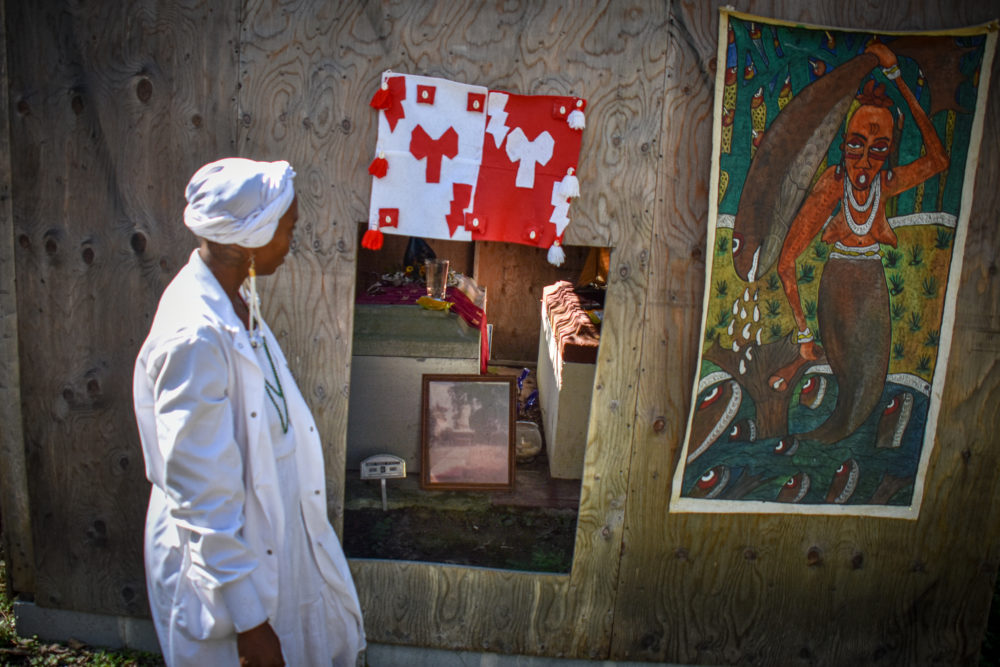October 2021: With a three-day weekend close to Halloween and on Maricienne’s birthday, my wife’s mom, we decided to fly out to the old historical city of Savannah, Georgia. We started our trip in Charleston, South Carolina, where we rented a car, and we drove to another historic town of Beaufort, albeit much smaller than Savanah. Beaufort, South Carolina, is near Parris Island, the east coast version of Camp Pendleton, a training center for US Marines. The region of Beaufort surrounded by Cyprus swamps and old plantation houses and streets lined with old oak trees dripping with Spanish moss dates back to pre-Revolution War days. We had two nights on this trip, and to get a mix of experiences, I chose one in the small town of Beaufort and the other in the large city of Savannah. Beaufort and its region along the Atlantic Ocean did not disappoint.
Beaufort Region, South Carolina

Map of Beaufort and Savannah, where we based most of our weekend trip.
Day 1) In Beaufort, we stayed in a guesthouse of an old mansion built in the 1800s. We checked in, dropped our stuff off, and hurried off to explore the town and eat southern cuisine in one of the town’s most popular eateries, the Old Bull Inn, a dimly lit atmospheric bar with a reputation for great food.

Our home for the night in the Beaufort Inn

Sleepy town of Beaufort, South Carolina

Old Town of Beaufort with quiet streets lined with Oak trees dripping with Spanish moss
After dinner, I decided nighttime would be the perfect time to visit the old haunted ruins of St. Helena Chapel of Ease, built circa 1740. We had to drive across the bridge to St.Helena Island down a small road into the cypress forests to reach this place. The ruined church was used as a place of worship from 1740 until the Civil War. After the Civil War, it was converted into a school for formerly enslaved people until it burnt down in 1886. The remaining frame stands in a secluded grove of oak trees drooping with moss over a hundred years later. Visiting at night was creepy, but often I find if you want to really feel the history of a place, the best time to visit is at night. The church has a reputation for being haunted. The road next to it has had traffic fatalities supposedly due to apparitions suddenly appearing, causing the driver to swerve into an oak tree. If legends of ghosts are not enough, the church holds numerous old graves dating back hundreds of years. Adjacent to the church is an old vault with an open door, in which you can peer into the vault. According to legend, the Fripps (husband and wife) dedicated their lives to the upkeep of the old church. When they died, they were buried in the vault. After they died, the church started to fall into disrepair. Shortly, during the civil war, a group of Union soldiers vandalized the crypt looking for treasures. To enter, they removed the bricks that sealed the front door. The next day, the local townspeople replaced the bricks only for them to be removed and placed in an organized pile in front of the crypt the following day. This process replayed itself a few more times until it was just accepted that the ghosts of the Fripps did not want the bricks to be restored for some reason. The townsfolk gave up, and the crypt remains open to this day.
The church grounds are known for sightings of apparitions in 1800’s era dress. Although we did feel creepy vibes there, the only sightings I had were of giant mosquitos chomping on me while I tried to take long exposure photos of the church in the dark.

St. Helena Chapel of Ease

Paula in front of the St. Helena Chapel of Ease
Day 2: The following day, we woke up early to start our long day of sightseeing. We started by going to a breakfast café in town, where at 8 am, the café manager announced it was time to stand and pledge allegiance to the US flag. All of the cafe’s patrons, including us stood patriotically and pledged allegiance. Afterwards we returned to the Chapel of Ease, where we went the night before to see it in daylight.

An old fence that surrounded a graveyard near the Crypt of the Fripps- St. Helena Chapel of Ease
The next stop was an old fort built during the Spanish-American war to defend the deepwater harbor of Parris island against the Spanish, which was a threat during this time. After the war, the fort was left abandoned for decades and eventually purchased by the county.

Fort Fremont

Fort Fremont
From St. Helena Island, we returned to Beaufort to visit a cypress swamp where we saw a lot of wild alligators and Turn Turtles warming themselves in the sun.

Turn Turtle

One of many small alligators we saw in the Cyprus swamp in town
Near the cypress swamp was a local town museum and the caretaker, a local woman was happy to share the history of Beaufort and Port Royale. One of the most interesting things I saw in the museum was the list of very peculiar rules for male school teachers from in the 1870’s. Thankfully much has changed since those days.
From Port Royale, we drove to the town of Sheldon, its history pre-dating the Revolutionary war. We stopped at an old ruined church, Sheldon Church, which has survived being burnt down by the British during the Revolutionary war, rebuilt only to be burnt down again by the Union Army under General Sherman. It’s a beautiful place surrounded by old graves.

Rules for a male teacher in late 1800’s

Old Sheldon Church

Old Grave at Sheldon Church
Oyotunji African Kingdom
Near Sheldon, we came to what was probably the most interesting place we visited on the trip. At least it was the most culturally unique. I thought I was in West Africa for a few hours in South Carolina. Tucked away in the backwoods along the border of South Carolina and Georgia is a small self-proclaimed independent kingdom of 20 African Americans that have decided to return to the roots of their ancestors from West Africa. The village practices West African customs and voodoo and even has a self-declared king. Oyotunji was founded in the 1950s by a black nationalist group and has numbered in the hundreds at times. Throughout the village, there are several voodoo shrines and altars. There are even burial tombs of many ex-members. There are festivals and music, and true to West African voodoo, there are even sacrifices of chickens, goats, and dogs.

Oyotunji African Village

Portrait of the King

Voodoo Shrine with altar below it where live animal sacrifices are carried out
I had first found out about the village while researching out of the ordinary tourist locations in South Carolina. I found a phone number for the village and tried calling but could never get through, so we decided to just show up. Supposedly the town would take us on a tour of its compound for a fee. We turned off the highway down a dirt road through the forest before arriving at the gates to the village. The village is a few acres large and is full of West African-style shaped houses, art, voodoo statues, and shrines. We met a few women dressed in white voodoo gowns at the gate who offered to show us around for 20 dollars each, and they only took cash. It was evident from the start that the village was the real thing and not a tourist trap. Our guide showed us around speaking in a few words of Yoruba-Nigerian language, which she and others living in the village have learned. We passed a dozen voodoo shrines, and our guide greeted each one in Yoruba and sometimes even sang to them. We came across a few voodoo coffins that were next to the voodoo shrines with offerings of butter and food left on top of the coffins.

Our guide showing us the voodoo shrine of the ocean, which she said looked after the slaves as they crossed the ocean in slave boats from Africa

Voodoo Shrine

Coffin of one of the villagers
From the village, we stopped at a Waffle House. No trip to the south is complete without one visit to a Waffle House, even though it is always regretted afterward. From Sheldon, we set off for Savannah, Georgia, passing a few proudly displayed confederate flags posted along the side of the freeway I’m guessing, on private land. Once in Savanah, we checked in to our hotel, the Marshall Hotel, which dates back to before the Civil War.
Savannah, Georgia

The Marshall Hotel Built in 1800s
Savannah is really one of my favorite historical cities in the USA, along with New Orleans. As is the case with anything old, it is rich with a history of triumphs and tribulations. The British designed the city in the 1700s and became one of the most beautiful cities of the South with stunning old buildings, dozens of squares with fountains, and oak trees with more Spanish moss. The city was so beautiful that even General Sherman, who famously burned to the ground every town in his path, decided to spare Savanah.
Our hotel, the Marshall Inn, is a historical artifact in itself. General Sherman’s Union soldiers commandeered it as a hospital to treat the wounded, and hundreds of soldiers had limbs amputated, and many others succumbed to their wounds. So many limbs were amputated that hundreds of human bones were found discarded during a restoration beneath the floorboards. After the Civil War, the hotel was also used as an infirmary to keep sick and dying children from a Yellow Fever outbreak. This, of course, has earned the hotel the reputation as being one of the most haunted hotels in the country.

.The balcony of the Marshall Hotel Built in 1800s. Our room 205, the Mary Marshall room had a window that we had to crawl through to reach our balcony
Since our hotel was in the heart of historical Savannah, we walked all over exploring the squares, old houses and a favorite of ours, the Colonial Park cemetery dating back to the 1700’s

Colonial Park cemetery

Colonial Park cemetery
Savannah is the first structured city in the USA and has the oldest theatre. We easily could have spent a week in Savannah, and it was a shame we only had one night.

Savannah Square
We celebrated Maricienne’s birthday at Collins Quarter Restaurant and then joined a late-night ghost tour to learn about the cities many haunting tales. As described by our tour guide, Savannah is America’s most haunted city, a necropolis or a city built upon its dead! The last stop of the ghost tour was our hotel, which was considered one of the most haunted places. Our room in the Marshall Inn used to be the original owner’s room, where there were reports of apparitions.
One particular story about our hotel was that the 2nd floor (where our room is located) used to be the pediatric floor during the Yellow Fever outbreak. There have been reports where guests would awaken in the middle of the night with an “itchy sensation” on their feet, only to find a child tickling and playing with the soles of their feet. This left us a little spooked but excited. I learned from my wife that she had covered my feet with blankets after falling asleep that night. She also mentioned hearing clomping heels in the middle of the night and yelled across the room to her mom to check if it was her, only to hear the sound of silence since everyone was apparently in a deep slumber.
Stone Mountain
Day 3: We woke up early again the following day because we had to drive 3 hours to Atlanta, where our return flight would be. Before flying out, we stopped at the controversial Mount Rushmore of the South, Stone Mountain, which has the carvings of three of the most prominent figures of the Confederate South during the Civil War: President Jefferson Davis, General Robert E Lee, and General Stonewell Jackson. We took an aerial tram to the top, which took 14 seconds to travel 1500 feet and the views along the way were incredible.

Stone Mountain

Stone Mountain
Stone Mountain Controversy
Given that many Confederate memorials, statues, and names have been removed across the USA due to their association with slavery, it is no wonder that the largest Confederate monument, a mountain carved in the shape of the three most prominent Confederates inspired and founded by members of the Klu Klux Klan has received a lot of negative attention over the years. There have even been calls to remove the carvings from the face of the mountain but until now this hasn’t happened, maybe part of the reason why is the danger and huge cost associated with doing so. There have been efforts by the park to remove other monuments to the Confederacy and to build a museum dedicated to the horrors and injustices of slavery. Additionally, there is no mention of word memorial anywhere in the park for the mountain and instead park employees refer to the cut outs in the mountain of Jefferson Davis, General Robert E Lee, and General Stonewell Jackson as the “carvings.”

